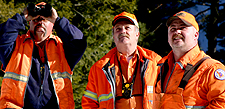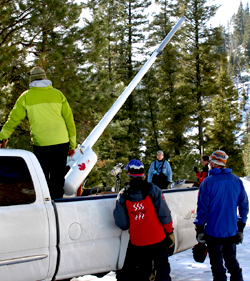
|
CONNECTIONS
|
IDAHO
ITD
HOME
IDAHO DMV
ITD NEWS
HIGHWAY
SAFETY
IDAHO STATE
POLICE
TRAVEL SERVICES
STATE OF IDAHO
NATIONAL
AASHTO
AAMVA
AAA of IDAHO
FEDERAL HIGHWAYS
FEDERAL AVIATION
IDAHO STATE POLICE
NHTSA
NTSB
TRB
U.S. DOT
Idaho
Transportation
Department
Public Affairs Office
P.O. Box 7129
Boise, ID 83707
208.334.8005
Fax: 208.334.8563
Email

ITD
tests explosives launcher on
Idaho 21's avalanche chutes
 An
aggressive approach to controlling more than 50 avalanche tracks along
a 10-mile segment of Idaho 21 is designed to reduce the number of winter
highway closures and limit the length of required closures.
An
aggressive approach to controlling more than 50 avalanche tracks along
a 10-mile segment of Idaho 21 is designed to reduce the number of winter
highway closures and limit the length of required closures.
The transportation department recently experimented with two methods of bringing threatening snow accumulations off the steep mountainsides before they cascade down on their own. One method involved dropping small explosive charges from a helicopter; the other process launched explosive charges from a truck-mounted cannon, called an Avilauncher.
 Nearly
80 percent of the avalanches that occur on the highway come from three
tracks between mileposts 96 and 100, said Bob Frisbie. The transportation
senior has worked the Canyon Creek area of Idaho 21 the past 16 years.
During normal winters, the stretch of highway may close up to a dozen
times, with some closures lasting more than a week.
Nearly
80 percent of the avalanches that occur on the highway come from three
tracks between mileposts 96 and 100, said Bob Frisbie. The transportation
senior has worked the Canyon Creek area of Idaho 21 the past 16 years.
During normal winters, the stretch of highway may close up to a dozen
times, with some closures lasting more than a week.
 Frisbie
said a proactive approach to managing the avalanches could narrow the
closures by more than 50 percent and reduce the length of closures from
weeks to a couple of days.
Frisbie
said a proactive approach to managing the avalanches could narrow the
closures by more than 50 percent and reduce the length of closures from
weeks to a couple of days.
Neither of the trial methods produced the dramatic results ITD crews had anticipated. Nature beat them to the job.
Approximately four-feet of snow moved down the tracks naturally a few days before the scheduled demonstration, Frisbie said.
Still, the Avilauncher proved accurate in delivering two-pound percussion charges to their destination about 1,000 meters away. The equipment is capable of sending the charges a distance of 2,500 meters with less accuracy, Frisbie explained. There was little doubt the equipment could be instrumental in making effective preemptive strikes against threatening snow chutes.
 Charges
dropped from helicopters also are effective, but probably would be more
costly in the long run; they also are limited by weather conditions.
Charges
dropped from helicopters also are effective, but probably would be more
costly in the long run; they also are limited by weather conditions.
In contrast, the Avilauncher can be moved among permanent bases along the highway with little set-up time. Explosive charges are propelled by compressed gas, and because they are not armed until after they are airborne, the process is relatively safe for ITD crews to administer.
The explosive charges carry enough power to dislodge snow from the steep slopes but do not damage the ground beneath the snow, Frisbie explained. They are “environment-friendly.”
About 15 people, including two U.S. Forest Service personnel, helicopter crews, Avilauncher representatives and ITD employees, were on hand for the Jan. 21 trial run.
Based on what they saw, ITD maintenance crews recommend purchase of the $15,000 tool.